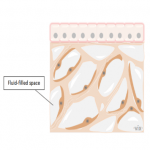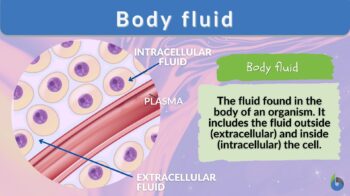
Body fluid
n., plural: body fluids
[ˈbɒdi ˈfluːɪd]
Definition: Any fluid found in a living organism
Table of Contents
Body Fluids Definition
What is body fluid? Literally, body fluid is the fluid of the body. The adult human body is ~50-60% composed of water, which is distributed inside the cells (intracellular) and outside the cells (extracellular). A total of intracellular and extracellular water forms the total body fluid.
Apart from water, the body fluid is also composed of other molecules, such as electrolytes (sodium, potassium, etc), metabolites (urea, glucose, carbon dioxide, oxygen), and proteins (albumin, hormones, amino acids, antibodies). Depending on the location of the body fluid, the composition and amounts vary.
The body fluid or the physiologic fluid is essential for various physiological processes and the maintenance of body homeostasis. The functions of water in the body include temperature regulation, moistening of tissues, transportation of essential nutrients, elimination of waste from the body, and lubricating different joints and tissues. Some example of body fluid includes blood plasma, tears, synovial fluid, sweat, and urine.
What percent of your body is water? or what percentage of water is the human body? The human body is primarily made up of water and the water distributed in different parts of the body organs and tissues is what defines the body fluid. The body fluid content of the body changes with the body’s development.
The maximum body fluid is present at the fetal development stage (~95%), which goes down to ~75% for an infant and eventually to ~50-60% in the adult stage (Figure 1).
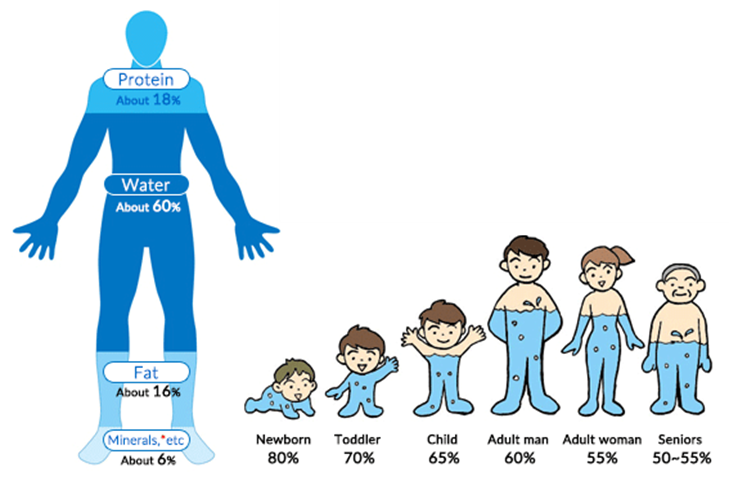
Watch this vid about body fluids:
Biology Definition:
A body fluid refers to any fluid produced by a living organism. In humans, the body fluid can be classified into two major types according to the location in the body:
- Extracellular fluid – the body fluid located outside the cell or cells of an organism. It makes up about 26% of the total body water composition in humans. Interstitial fluid, intravascular fluid, lymph, and transcellular fluid make up the extracellular fluid.
- Interstitial fluid (the fluid filling up the spaces between cells) is the major constituent.
- Intravascular fluid
- Transcellular fluid (the fluid filling up the spaces of chambers formed from the linings of the epithelial cells) is the least in terms of the amount.
- Intracellular fluid – the body fluid located within the cell or all cells of an organism. In humans, the intracellular fluid makes up 67% of the total body water composition. It is composed of water, dissolved ions, and other molecules.
Examples of body fluids: amniotic fluid, aqueous humor, bile, blood plasma, breast milk, cerebrospinal fluid, cerumen, chyle, exudates, gastric juice, lymph, mucus, pericardial fluid, peritoneal fluid, pleural fluid, pus, saliva, sebum, serous fluid, semen, sputum, synovial fluid, sweat, tears, urine, vomit
Synonyms: bodily fluid; biofluid
Body Fluid Compartments By Location
Types of body fluids can be categorized based on the location:
Intracellular Body Fluid
The fluid that is present inside the cell i.e., in the cytoplasm of the cell. The intracellular fluid largely remains unchanged and does not undergo rapid changes or fluctuations. Intracellular fluid forms ~40% or 2/3rd of the body fluid. Bodily fluids are distributed in different fluid compartments as shown in Figure 2.
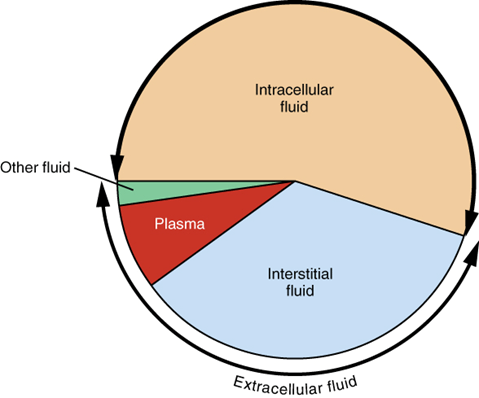
The majority of the chemical/metabolic reactions of the body occur in the cytoplasm or the intracellular body fluid. Intracellular body fluid is also involved in maintaining osmolarity via sodium-potassium pump wherein potassium ions are primarily intracellularly distributed.
Intracellular body fluid is composed of a high amount of potassium, phosphate, and magnesium while low amounts of bicarbonate, chloride, sodium, and protein (Figure 3).
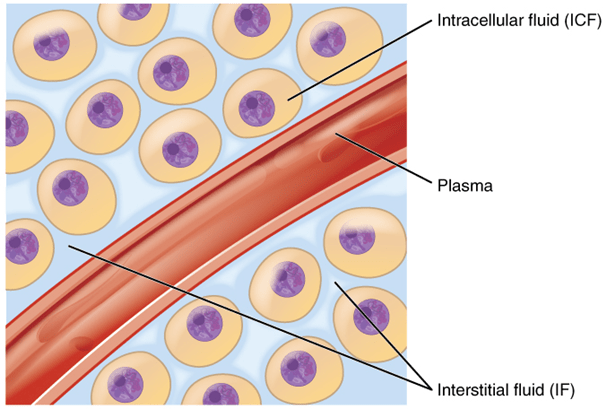
Did you know …?
Males have a higher amount of body fluid as compared to females as females have higher body fat. Fat tissues tend to have less water than lead body mass.
Extracellular Body Fluid
Almost 20% of the total body weight is an extracellular body fluid (Figure 2). Extracellular fluid differs from intracellular body fluid in sodium, potassium, and protein content. In extracellular fluid, electrolytes that are abundant or in relatively high amounts are sodium, chloride, and bicarbonates. Other electrolytes present but are comparatively at lower levels (than the intracellular fluid) are potassium, phosphate, and magnesium.
- Major electrolytes in extracellular fluid:
- Sodium – the osmotically active cation in the extracellular fluid
- Chloride – the predominant anion in the extracellular fluid
- Bicarbonates – important in maintaining the acid-base balance; abundant in intracellular as well
- Electrolytes that are in relatively small amounts in the extracellular fluid:
- Potassium – occurs more inside the cells than in extracellular fluid
- Phosphate – an anion that is predominantly intracellular than extracellular
- Magnesium – a cation that is predominantly intracellular than extracellular
- Calcium – another predominantly intracellular cation
- Major electrolytes in extracellular fluid:
The extracellular body fluid consists of interstitial fluid, intravascular body fluid, and transcellular body fluid.
- Interstitial body fluids. Interstitial fluid or Intercelluar fluid constitutes 5% or 2/3rd of the extracellular body fluid. This is the fluid present within and around body tissues (Figure 3). For example,
- Lymphatic fluid
- Renal interstitial fluid
- Interstitial fluid in the lungs where the interstitial fluids contain proteins, nutrients, chemical messengers, and oxygen in it.
- Intravascular body fluid. Intravascular fluid forms almost ~12% or 1/3rd of the extracellular body fluid. Intravascular fluid is the fluid present in the intravascular space in the blood vessels (Figure 3). Example: blood plasma. The intravascular fluid is rich in protein content, sodium chloride, and bicarbonate. Plasma is the vehicle or the fluid wherein red blood cells and white blood cells are suspended or reside. The primary function of the intravascular fluid is for transportation.
- Transcellular body fluid. Transcellular fluid includes intraocular, peritoneal, pleural, cerebrospinal, digestive, and synovial fluid.
Intracellular body fluid and extracellular body fluid together constitute the total body water or TBW.
Often a question arises, Is lymph extracellular fluid? The body’s circulating fluids include lymphatics and blood. Notably, blood plasma constitutes the intravascular fluid while lymph forms the interstitial fluid. Thus, lymph is an extracellular interstitial fluid.
Blood is the alkaline body fluids of the human body.
Body Fluid Mechanism
The body maintains tight control over total body water and total body osmolarity, thus ingestion and excretion of water are regulated. The water in different components of the compartment is maintained to match total body osmolarity and in process of maintaining a steady-state redistribution of water from the different compartments of the body can occur. The redistribution of water in different compartments of the body is controlled by:
- Osmotic pressure. The osmotic pressure is the force created by the fluid. Part of the osmotic pressure is the oncotic pressure (i.e., which is the osmotic pressure created by the large molecules (colloids). The osmotic pressure is also called the colloidal osmotic pressure.
- Hydrostatic pressure. The hydrostatic pressure is the force that drives fluid transport (e.g., capillary hydrostatic pressure, or CHP, the hydrostatic pressure that blood exerts against the capillary wall)
While osmotic pressure pulls the fluid (water and the dissolved molecules it carries) back into the capillary, the hydrostatic pressure pushes the fluid out of the capillary. The fluid that exits the capillary moves into the interstitial fluid. This process is referred to as filtration. In contrast, the fluid from the interstitial fluid back into the capillaries is what drives the reabsorption process.
Read Tutorial: Kidney and Regulation of Water and Inorganic Ions
Further, intercellular fluid and intracellular fluid are in dynamic equilibrium with each other as they are separated by a cellular membrane and fluid movement is in dynamic equilibrium.
In general, the cellular waste is excreted out of the cell in the intracellular fluid while in exchange, the nutrients are ingested from the intracellular fluid.
Water movement occurs passively across the membrane depending on the osmotic gradient. Conversely, ion movement is not permitted across the membrane and occurs occasionally (depending on the cellular requirement) through active transport. Ions in the body fluids of a human are referred to as the electrolytes in the body.
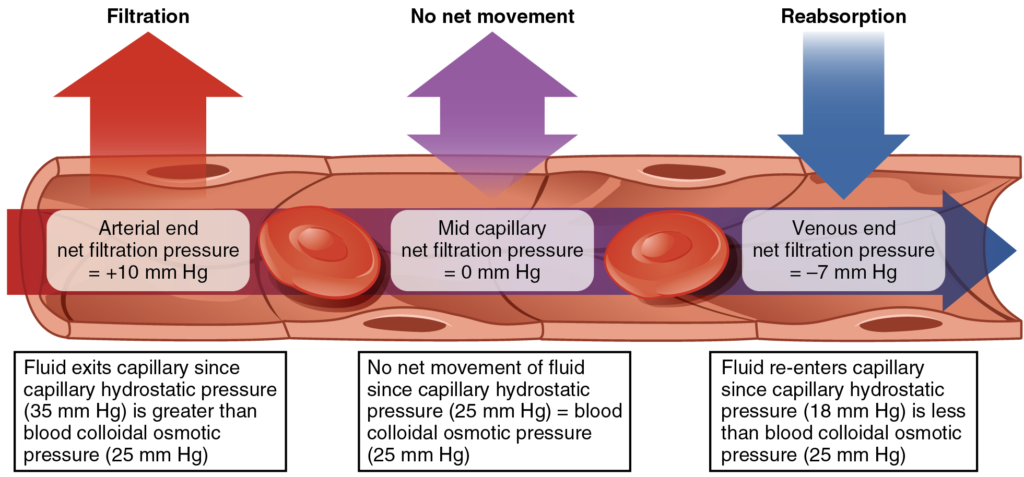
Health
Body fluid balance is essential for homeostasis. Water/sodium balance in the body is tightly regulated by the nervous system. Otherwise, any disturbance in the body fluid results in abnormal health conditions wherein there can be an increase in body fluid load/ fluid volume or a reduction in the body fluid.
Excess fluid in the body or increased fluid results in edema whereas a reduced body fluid amount is referred to as dehydration. Edema can occur in any part of the body/tissue, for example, soft tissues, liver disease-induced edema, pulmonary edema, excess abdominal fluid or ascites, etc.
Pulmonary edema, in particular, is a major health risk as it compromises gas exchange. Edema is seen when the body retaining fluid results in an accumulation of water in the tissue, for example, hand fluid retention results in hand edema. Diuretics help to manage edema. Conversely, reduced water intake or conditions like diarrhea and sweat can result in dehydration.
This goes to show that similar to food intake having a major role in energy balance, fluid intake also is key to keeping a healthy body fluid balance. Body fluid homeostasis is thus essential in ensuring that the body fluid is kept stable and it does so by maintaining the body osmolality (the concentration of all particles dissolved in the body fluid) within the normal limits while the extracellular fluid and blood volume (the amount of fluid circulating inside the blood vessels) are kept adequate.
Body fluid can also be a carrier of certain diseases like sexually transmitted diseases (HIV-AIDS) and viral diseases (hepatitis).
Good to know!
Skin turgor or skin elasticity is an indication of the hydration level of the body and is often used to diagnose dehydration. Decreased urine output is also an indication of dehydration.
Clinical Samples
Non-infectious body fluids (blood and blood products, sweat, saliva, excretion products, tissue fluids, and intracellular body fluids like synovial fluid) can be used for the diagnosis of any disease or medical condition.
Sampling
The analysis of various body fluids helps to establish any medical condition. For the same, the sample can be obtained as follows:
Table 1: Techniques for body fluid sample collection | |
|---|---|
| Site of sample collection | Technique |
| Arterial blood sample | Radial artery puncture |
| Venous blood sample | Venipuncture |
| Peritoneal fluid sample | Paracentesis |
| Synovial fluid | Arthrocentesis or joint aspiration |
| Amniotic fluid | Amniocentesis |
| Cerebrospinal fluid | Lumbar puncture |
| Pleural fluid | Thoracocentesis |
| Fluid in pericardial cavity | Pericardiocentesis |
Data Source: Dr. Amita Joshi of Biology Online
Answer the quiz below to check what you have learned so far about body fluids.
Further Reading
References
- Bianchetti, M. G., Simonetti, G. D., & Bettinelli, A. (2009). Body fluids and salt metabolism – Part I. Italian journal of pediatrics, 35(1), 36. https://doi.org/10.1186/1824-7288-35-36
- Brinkman, J. E., Dorius, B., & Sharma, S. (2018). Physiology, body fluids.
- Roumelioti, M. E., Glew, R. H., Khitan, Z. J., Rondon-Berrios, H., Argyropoulos, C. P., Malhotra, D., Raj, D. S., Agaba, E. I., Rohrscheib, M., Murata, G. H., Shapiro, J. I., & Tzamaloukas, A. H. (2018). Fluid balance concepts in medicine: Principles and practice. World journal of nephrology, 7(1), 1–28. https://doi.org/10.5527/wjn.v7.i1.1
- Tobias, A., Ballard, B. D., & Mohiuddin, S. S. (2019). Physiology, water balance.
©BiologyOnline.com. Content provided and moderated by Biology Online Editors.








